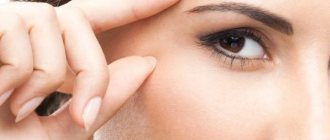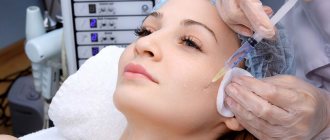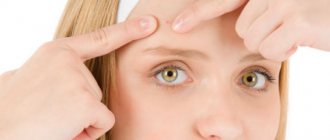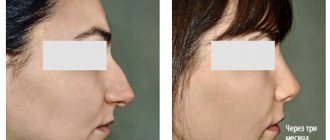Description of facial asymmetry
Normally, imbalances in proportions do not exceed 2-3 millimeters. The left side of the face is characterized by femininity and smoothness of features.
They are slightly elongated in the vertical plane.
The right side is slightly wider, more defined and sharp. But there are also pronounced facial asymmetries associated with profound disorders.
It is not difficult to distinguish physiological deviations from pathologically disturbed proportions. To do this, just look in the mirror. The deformity is expressed in a skewed chin, noticeable displacement of the corners of the mouth, one cheekbone higher than the other. Jaw displacement is not only a problem of aesthetics, the bite is also disturbed, bruxitis may begin to develop, which as a result is fraught with large inconveniences and expenses during treatment. Find out what to do if your jaw is jammed on one side.
Disproportional face in children
A disproportionate face in children is not always a sign of pathology; before the age of 12 months, doctors generally do not recommend paying attention to this nuance in appearance. But after a year, if the asymmetry persists and is clearly visible, it is worth turning to specialists for help - the sooner corrective measures are taken, the better the final result will be.
Asymmetry in children belongs to the group of congenital ones and can be caused by:
- uneven, with disturbances in the development of facial bones in utero,
- malpresentation of the fetus,
- complex entanglement of the umbilical cord,
- the use of obstetric forceps during childbirth causes injury to the facial nerve,
- muscle spasms,
- complicated childbirth with incorrect position of the fetus - bone deformation occurs during the passage of the birth canal.
In newborns, facial disproportion can be caused by regular attacks of epilepsy. This condition is difficult to diagnose because the newborn is not able to talk about the problem, and convulsive seizures are regarded as imperfect coordination of movements.
If we talk about acquired facial asymmetry in a child, it can develop against the background of:
- birth injuries - very fast, or vice versa - protracted, childbirth, delay in pregnancy, fetal hypoxia,
- congenital torticollis – during childbirth the baby injured the sternocleidomastoid muscle, during pregnancy the fetus suffered an intrauterine infection,
- acquired torticollis - toys were hung or placed in the bed on only one side, so the newborn was forced to use only one side of the body in examining them.
In older children, a disproportionate face may be due to:
- jaw injuries,
- malocclusion,
- lack of teeth,
- inflammatory processes in nerve processes.
We recommend reading about plastic surgery options for the face and neck. From the article you will learn about the types of plastic surgery and indications for its implementation, when reconstructive plastic surgery of the face and neck is indispensable.
And here is more information about the effectiveness and results of using Botox for the face.
Symptoms of deformation of the jaw, chin, cheekbones
Facial asymmetry has manifestations. Based on these symptoms, a diagnosis can be made:
- sagging cheeks due to weakness of facial wrinkles;
- the affected part of the face takes on the appearance of a mask, the corner of the lips moves down;
- smoothing natural frontal and nasolabial folds;
- the pained expression of the asymmetrical half;
- obvious violation of facial expressions (difficulty closing an eye, lifting a lip or wrinkling a forehead);
- widening of the palpebral fissure.
In complex cases with damage to the facial nerve, symptoms intensify.
Sometimes the signs are accompanied by pain.
If muscle function deteriorates significantly and affects the side of the neck, the patient develops a pathological tilt of the head. Gradually, one cheek sags, and the sore side of the face smoothes out. Often there are problems with nutrition, and pain manifests itself precisely during chewing food. This material will tell you why teeth go numb.
Causes
There are several factors for the occurrence of facial asymmetry. These may include physiological and pathological disorders. The development of incorrect facial proportions is based on cosmetic, neurological, dermatological and dental problems.
Congenital facial defects leading to asymmetry are quite rare.
Usually, deviations are detected already in the prenatal period, when the fetus is actively developing. Sometimes such disorders are accompanied by various syndromes.
There is also senile facial asymmetry. This is due to age-related changes against the background of developing muscle weakness.
Varieties of curvature
The following changes are observed: a crooked mouth, chin, cheekbones, and a skewed jaw to one side.
Congenital and acquired
Congenital:
- abnormal structure of the cranial bones;
- underdevelopment of the lower jaw;
- developmental disorder of the temporomandibular joint;
- improper formation of the neck muscles;
- damage to connective tissues and the muscular system.
Purchased:
- injuries to the face, jaws, facial bones;
- inflammation or pinching of the facial nerve;
- malocclusion;
- complete secondary and primary adentia (absence of teeth);
- strabismus;
- soft tissue atrophy due to systemic diseases;
- torticollis in children.
Natural and pathological
Physiological reasons
These factors include bad habits. Incorrect posture with a characteristic tilt of the head to the side for a long time leads to facial asymmetry. The face can change if you constantly chew gum on one side of the jaw or squint your eyes.
If a person sleeps on one side for a long time, this leads to facial distortion.
Pathological:
- neuropathic defects of the facial nerve, Bell's palsy;
- facial contracture after paralysis with increased tone on the healthy side of the face;
- synkinesis (involuntary movements of the muscles of the face or eyes);
- dyskinesia of facial muscles;
- pain syndromes on one side of the face;
- myasthenic syndrome accompanied by asymmetry.
One cheek is thicker than the other reason
Dentists never tire of repeating that the loss of a tooth, and especially several, is also a serious aesthetic problem. The connection between a full set of teeth and a beautiful oval face is the most direct. After tooth extraction, the bone partitions from which the tooth socket was formed gradually dissolve, and a dent forms on the jaw.
At the same time, the jaw is deformed, slightly decreasing in height and diameter. This leads to tension in small facial muscles and the formation of new wrinkles or the deepening of old ones. If several teeth are missing in the lower jaw, the angle of its location may change, and the soft tissues of the face may shift, forming wrinkles and creases.
Treatment
In most cases, surgery is used to correct asymmetry. Thanks to facial plastic surgery, it is possible to achieve significant alignment of facial proportions.
Surgical intervention
Before plastic surgery, preparation is required. Usually, to diagnose complex facial asymmetry, an external examination, collection of complaints and consideration of anamnesis are sufficient. A study is required to check for possible inflammation and soft tissue infections. Until they are eliminated, surgical treatment cannot begin. Facial proportions are measured using special instruments. If the affected side is displaced by more than 5 degrees, the doctor suggests various types of correction. Find out about the removal of a horizontal, recumbent tooth in this article.
A neurologist will help determine the extent of the facial nerve defect. X-rays are required if the asymmetry is associated with facial trauma. In addition to consulting a surgeon, you will need to undergo an examination by an ophthalmologist, neurosurgeon or dentist.
The final stage of preparation for surgery will be magnetic resonance imaging.
Such a study gives an accurate picture of bones and soft tissues.
Types of operations
- Thread lifting. Polydioxanone threads are injected subcutaneously and dissolve on their own. Gradually, collagen fibers form in their place. Plastic surgery is suitable for patients with physiological asymmetry caused by age-related changes in the facial contour. The procedure lasts 30-60 minutes, the average duration of the effect is 2 years.
- Contour plastic. The cosmetic method involves the use of injections or implants. Thanks to the operation, you can achieve maximum face lifting and eliminate visible asymmetry. Contour plastic surgery has many contraindications, which are voiced by a specialist.
- Blepharoplasty . Used to correct the skin fold above the eye. With the help of eyelid surgery, pronounced asymmetry of the eyes is eliminated. Additionally, blepharoplasty makes it possible to get rid of swelling under the eyes. If the patient has synkinesis associated with neurological abnormalities, eyelid surgery may not be effective.
- Browlift. Browplasty is used to move an asymmetrical eyebrow to a higher position. This method is often used if implants alone are not enough or correction of the forehead is required.
- Rhinoplasty. Used to correct the nose after various injuries. The operation lasts no more than 1.5 hours.
Find out about digital orthopantomography of teeth by clicking on this link.
Massages
If asymmetry is not associated with complex injuries and damage to the facial nerve, you can correct your face with the help of massages.
Unfortunately, this is difficult to do at home.
Only a specialist knows the massage lines and is able to restore the contours of the cheeks and other areas of the face. Finger and palm exposure is effective in case of long-term use. It will take 10 to 20 sessions to achieve the effect.
Facial deformation and variants of its manifestation
Facial deformation (distortion, asymmetry of the eyes, eyebrows, cheekbones, nose) can occur in different directions, its specific types can guide the doctor in making a preliminary diagnosis and selecting the necessary examinations, then effective methods of correction, including surgical options for solving the problem, removing the causes medicines.
Facial distortion
Facial distortion most often occurs with peripheral damage to the facial nerve against the background of its inflammation. Such changes in appearance develop “suddenly and immediately”, so visits to the doctor are made urgently.
Diagnosis of damage to peripheral nerves should be carried out with the differentiation of stroke - with this pathology, a disruption of the functioning of the same nerve is observed, but according to the “central type”. You can determine what exactly caused the sudden distortion of the face yourself:
- during a stroke, a person can close his eyes tightly, while a peripheral lesion prevents this from happening (the eyelids do not close),
- if the victim is able to “pull” his eyebrows as tightly as possible, then we will be talking about an emergency cerebrovascular accident (stroke),
- sagging of the corners of the mouth and the inability to smile fully on the affected side are a characteristic sign for both pathologies.
If there is a suspicion of a stroke, the patient should be in bed, and an ambulance team should be called to the house. Any movements, especially walking or riding vehicles without special devices, are contraindicated for him - a full-fledged hemorrhage in the brain can occur, and complete paralysis can occur.
Eye asymmetry
Asymmetry of the eyes can manifest itself in strabismus, the location of one higher in relation to the other. Most often this problem occurs against the background of:
- disorders in the jaw area - incorrect structure of the lower part (or previous injuries), problematic bite, absence of several teeth,
- neurological diseases, damage to the facial nerves by inflammatory and infectious diseases.
During diagnosis, the ophthalmologist will definitely check the patient’s level of vision and measure the proportions of the entire face. Pathological deviations are considered to be the difference between the location of the palpebral fissures of 3 mm and 5 degrees.
Since eye asymmetry can appear against the background of rapid growth of a malignant tumor, a consultation with an oncologist will be required after the presence of a formation in the cranial cavities is detected.
In addition to visual examination, hardware methods are also used for diagnosis - in this case, magnetic resonance imaging of the face and x-ray of the skull will be informative.
One eyebrow is higher than the other: how to fix it
The situation where one eyebrow is higher than the other can be corrected through surgery, but here it is required extremely rarely, only in particularly advanced cases. Usually, doctors first carry out diagnostic measures, then prescribe a course of therapy (if any disease such as inflammation of the facial nerve has been identified) and only after that they recommend using the services of experienced cosmetologists and makeup artists.
In fact, such asymmetry is a normal phenomenon that is rarely associated with pathological processes. But one eyebrow can be located higher than the other due to inflammation of the facial nerves and congenital strabismus.
Often, the disproportionate location of the eyebrows indicates a person’s physiological habits - for example, when surprised or very excited, he raises one eyebrow, chews food only on one side of the jaw, constantly squints with a low level of vision.
Asymmetry in the cheekbones
Asymmetry in the cheekbones may appear due to:
- Missing teeth. The fact is that tooth loss leads to the resorption of bone partitions and the formation of a dent. As a result, the facial muscles become tense, which makes the face in adults disproportionate. If the lower jaw is missing several teeth, then the soft tissues of the face are displaced due to changes in the angle of the bones.
- The habit of chewing food on only one side of the jaw . The load on the muscles is distributed unevenly; toned (overstressed) muscles simply pull on one side of the face. Asymmetry in the cheekbones especially often appears in those people who love chewing gum.
- Night rest in a position on your stomach or side . The tissues adjacent to the pillow are constantly under strong pressure and very slowly begin to deform. One cheek becomes larger than the other, the oval of the face changes.
The problem may lie in the progression of neurological pathologies, inflammation of the facial nerves, injuries and fractures, and improperly performed plastic surgeries.
Nasal asymmetry
Asymmetry of the nose can manifest itself in the form of irregularly shaped nostrils or their different sizes, deviation of the tip of the organ from the midline. The reasons are:
- individual features of the anatomical structure of the nasal septum,
- problems in the intrauterine development of the skull bones - for example, the appearance of a “cleft lip” or “cleft palate” defect,
- unsuccessful rhinoplasty,
- mechanical injury.
Severe nasal asymmetry affects breathing, so in such cases doctors strongly recommend surgical intervention to improve the condition and functionality of the respiratory system.
One side of the jaw is larger than the other
Most often, one side of the jaw becomes larger than the other for mechanical reasons - missing teeth or bone injuries (displaced fractures). This type of asymmetry can also be caused by a tumor developing in the soft tissues of the chin or cheeks.
The disproportion of the lower part of the face entails a skew of its other parts - one cheekbone is visually located higher/lower than the other, one of the eye slits may be narrower, and so on.
Asymmetry of the lower jaw
Asymmetry of the lower jaw is its skew to one side, which can be obvious (visible to the naked eye) or hidden (visible only from below). The causes of the problem may be sleeping on one side of the face, incorrect posture, and the habit of chewing food in a “one-sided” order. Sometimes a crooked jaw indicates the development of a pathology such as partial paralysis, inflammation of the facial nerves, or tumor growth in the soft tissues.
The jaw can be corrected surgically if the cause of the problem is mechanical damage to the bones. In some cases, it is enough to treat the pathology (tumor removal, anti-inflammatory therapy, dental prosthetics) and resort to cosmetic procedures to straighten the facial contour.
Watch this video about the causes and treatment of facial asymmetry:
Asymmetrical smile
An asymmetrical smile is a sign of a neurological disease. Most often, doctors use it to diagnose inflammation of the facial nerves, but be sure to rule out a stroke. The solution to the problem is to carry out full treatment of the underlying disease, correction of soft tissues with fillers and Botox injections.
The latter applies only if the incorrect smile arose more than 6 months ago, and the person simply did not seek qualified medical help about this.
Lip asymmetry
The causes of lip asymmetry are:
- features of the anatomical development of this part of the face,
- trauma to the upper or lower jaw,
- myasthenic syndrome,
- cerebrovascular accidents,
- inflammatory processes in the nerves,
- neuropathies of various origins.
The choice of treatment method depends on the cause of the defect, but surgical intervention is only appropriate if there is a history of jaw trauma, after which the bones were not fused correctly. The most commonly used cosmetic procedures are:
- vve
Possible complications: malocclusion, nervous tics
Uncorrected asymmetry or complete lack of treatment can have consequences. This applies to both the physiological and psychological sides:
- twitching of facial muscles;
- involuntary nervous tic of the eyes and other parts;
- increased risk of soft tissue inflammation;
- chronic headaches;
- high blood pressure;
- stress on the jaws and neck.
Often, against the background of incorrect facial proportions, the patient experiences psychological instability. In the social sphere such a person may feel depressed.
To maintain proportions after surgery, you must adhere to the recommendations of the plastic surgeon.











